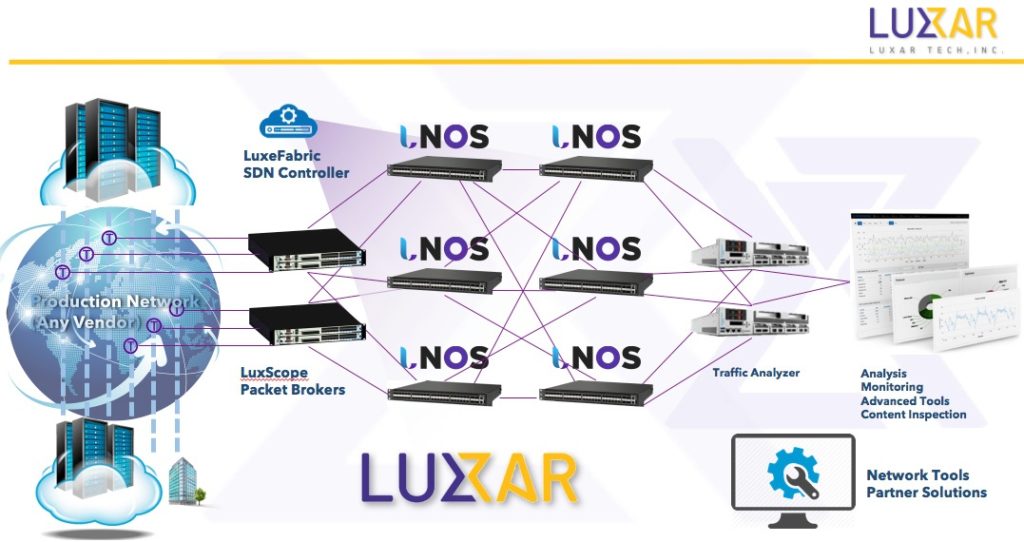LUXAR'S SDN EMPOWERED NETWORK VISIBILITY
The network is the lifeblood to a telecommunications service provider’s (carrier) business, which provides the transport for the revenue-generating applications and services to their end customers, Visibility of network traffic is the fundamental enabler of essential information by Extracting packets from the carrier network and analyzing them.
Today, with SDN technology, carriers can now build a scalable traffic analytics farm. Luxar Tech is providing a visibility fabric built with SDN technology that provides the pipelines for extracting, grooming, aggregating, and distributing the traffic to an analytics tool for analytics and performance management.

VISIBILITY FABRIC FOR ANALYTICS AND REPORTING: AN OVERVIEW
A visibility fabric enables packets to be copied from the carrier network without intrusion or adding risk of disrupting the carrier network traffic Packets can be copied using passive optical splitters placed at various extraction points of the carrier network. The copied packets can be aggregated to packet brokers for speed conversion, filtering, load balancing, slicing, time-stamping, header-stripping, and header modification. The packet brokers send the tapped traffic to a fabric of spine and leaf Ethernet SDN switches to which a cluster of servers are connected that host the applications that provide traffic analytics and reporting for the network operators to consume. In a nutshell, the visibility fabric comprises a layer of optical splitters and packet brokers, connecting to an Ethernet switch fabric, that feeds the traffic into various analytics appliances.
SOLUTION COMPONENTS
Optical Splitters
An optical splitter is a passive network element to be inserted onto an optic fiber to make a copy of the optical signals by splitting some optical energy from the original optical signals. The original communication is not affected. By using optical splitters at various extraction points of a network, traffic can be tapped for analysis.
Packet Brokers
A packet broker is a purpose-built device for traffic applications. It can serve various functions such as:
Converting traffic from one speed to another
Converting traffic from one medium to another
Filtering uninteresting traffic so that uninteresting traffic would not consume analytics appliance bandwidth
Slicing packets for bandwidth efficiency or privacy compliance
Load balancing traffic to multiple instances of an analytics tool
Replicating traffic to multiple analytics
LuxeFabric Controller
LuxeFabric controller is an SDN controller based on OpenDaylight. LuxeFabric controller instructs the LuxeFabric switch hardware with forwarding rules in the data plane.
Meanwhile, it presents REST interfaces for applications to program the controller and hence the fabric. It is built with open networking technologies such as OpenDaylight and OpenFlow. It can be installed on a physical server or a virtual machine. It also supports active-standby redundancy. LuxeFabric provides all the benefit of an OpenFlow-based SDN. It offers a fl network automation and management framework, which will enable rapid service introduction, reduce operational overhead, and decrease network instability introduced by operator error.
LuxeFabric encompasses the benefit of both a traditional L2 network and a traditional L3 network yet without the drawbacks of either. The LuxeFabric controller has built-in equal-cost-multi-shortest-path forwarding intelligence. With none or a few configurations, you have a network whose redundant paths are fully utilized. Also, LuxeFabric controller makes no assumption about network topology. Therefore, you are not limited to a spine- leaf Clos network topology. More importantly, the network can be scaled out as needed. On the other hand, LuxeFabric is able to interoperate with a traditional L2/L3 network.
LuxeFabric can serve multiple purposes, some relevant to visibility fabric. First, it enables tapped packets to be forwarded and load-balanced from the packet brokers to the analytics server cluster. Secondly, it enables the analytics server to exchange messages among themselves and the main database or other data storage systems (e.g., as in a Hadoop cluster). Thirdly, it can be connected to a traditional L2/L3 network for a remote client to retrieve analytics reports from the analytics server cluster.
LuxeFabric Switch Hardware
LuxeFabric switches are OpenFlow switches qualified by Luxar to ensure compatibility and integrity. Luxar has qualified LNOS-driven switches. Luxar8 provides LNOS, the network operating system running on and managing the switch hardware.
LuxeFabric Switch Operating System Software
The LuxeFabric switches run LNOS, a market-leading network operating system software for white box switches. LNOS eliminates vendor lock-in by delivering open, hardware- agnostic networking. Built on Linux, LNOS incorporates a full Layer-2 and Layer-3 feature set with support for OpenFlow, OVSDB, and other key SDN protocols.
Analytic and Monitoring Tools.
Luxar has partnered with various to provide tailor made solutions for your enterprise, for detailed information, please contact us.